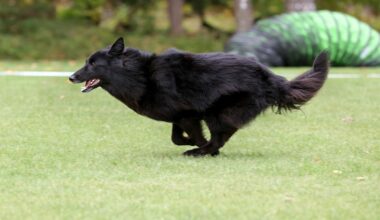Exercise Equipment Suited for Senior Dogs
When considering the best exercises for senior dogs, it’s essential to choose suitable exercise equipment that accommodates their changing abilities. As dogs age, they may develop stiffness and reduced mobility, making traditional exercise more challenging. To enhance their agility and comfort, look for specialized equipment designed specifically for older dogs. It’s vital to prioritize their safety and comfort, ensuring that the equipment is easy to use. Invest in low-impact options such as resistance bands and soft rubber balls. Additionally, balance discs can significantly improve core strength and stability. Furthermore, always consult with a veterinarian to tailor an exercise routine promoting health and fitness. Gradually introduce these activities and monitor their reactions. Gentle stretches using supportive bands can relieve tense muscles, allowing your furry friend to feel relaxed and rejuvenated. Lastly, ensure that you provide plenty of fresh water during exercise sessions. Regular exercise not only helps maintain their physical health but also enriches their mental well-being, making your senior dog feel youthful and animated. Take your time, enjoy the process, and create a fitness plan tailored for your dog’s unique needs.
Enrichment is vital for senior dogs, and incorporating comfortable exercise equipment can greatly enhance their daily activity. Adjustable harnesses offer excellent support without straining their joints. Choosing equipment that makes exercise enjoyable is essential for keeping senior dogs motivated. For example, lightweight toys that are easy to carry can spark playful interactions. Introducing soft agility tunnels or lightweight cones can help encourage movement in a fun way. If you have outdoor space, consider a low-impact mini obstacle course, which encourages slower, deliberate movements. Incorporating interactive toys that dispense treats or rewards can captivate their interest and stimulate cognitive functions. Monitoring your dog’s response to various equipment is critical; adapt the routine based on their comfort level and capacity. Regular breaks are essential during exercise sessions, allowing these gentle giants to rest. Additionally, their mental stimulation is as crucial as physical activity, so combine both aspects in your exercise routine. Include brain games using puzzle toys for moments of mental engagement and fun. Regular interaction with your dog fosters a strong bond and promotes an active lifestyle, which is important for their well-being and fosters a loving environment.
When investing in exercise equipment for your senior dog, consider its durability and ease of use. Many options on the market combine affordability with functionality. Rubber mats provide excellent grip, preventing slips and falls during low-impact exercises. This is particularly important for senior dogs, whose reflexes and balance may not be what they used to be. Similarly, soft foam rollers can alleviate stiffness while promoting circulation through gentle stretching exercises. Look for toys that are designed for seniors, offering softer materials that are kinder to their teeth and gums. Durable yet gentle toys ensure you can engage in play without worrying about your dog getting hurt. Also, consider mobility aids like ramps or harnesses that can help your dog access their favorite spots without straining their joints. It’s crucial to adapt your dog’s exercise as necessary. As soon as you notice any discomfort or unusual behavior, stop immediately and reassess the current activities. These small adjustments can contribute significantly to your dog’s quality of life and comfort, allowing them to enjoy their twilight years with grace and joy.
Creating a Tailored Exercise Routine
Creating a tailored exercise routine for senior dogs requires careful consideration of their specific needs and abilities. Understanding their limitations is essential when choosing exercises that will work for them while avoiding strains or injuries. Each dog’s unique personality plays a role in the types of equipment and activities they enjoy. Start with short sessions and gradually increase duration as their strength improves. Prioritize low-impact options such as leisurely walks, gentle swims, or slow-paced games of fetch that allow them to move at their own pace. Regularly assess their stamina and energy levels to ensure you’re not overexerting them. Incorporate basic stretching exercises into your routine to improve flexibility and joint mobility. Additionally, consider incorporating interactive toys, which can stimulate your dog’s mind and promote engagement. Choose equipment that is adaptable, allowing you to modify exercises as your dog progresses or faces challenges. Collaborate with a professional dog trainer or a canine physical therapist for personalized guidance. Ultimately, the aim is to foster a fun and enjoyable atmosphere that encourages activity, ensuring your senior dog remains healthy and satisfied.
As your senior dog engages in their tailored activities, remember to track their progress and make necessary adjustments. Keeping a journal or log can help you note any changes in behavior, including energy levels and enthusiasm during sessions. A positive approach is vital, so be patient as you introduce various exercises and equipment. Be sure also to check in with your vet regularly, as they can offer invaluable advice on managing your dog’s health. For instance, weight control is critical for senior dogs, and modifications in activity may be required should your dog need to shed extra pounds. Furthermore, using bright colors for toys and equipment can help make them more appealing and motivating for your senior friend. Dogs are naturally drawn to visual stimuli; thus, colorful products can enhance their play experience. Overall, your primary focus should remain on creating enjoyable moments together while promoting healthy habits. Regular bonding time through exercise not only enhances their physical health but strengthens the positive connection you share. Remember that quality is more important than quantity when navigating the journey of senior dog fitness.
Safety Considerations
Safety considerations are paramount when exercising senior dogs, as their unique physical requirements pose specific challenges. Always carry a first-aid kit during outings to address unexpected injuries promptly. Opt for local parks or environments that are dog-friendly and low-traffic, minimizing stress and hazards. Before beginning any exercise regime, warm-up activities are crucial for preparing your dog’s muscles. Incorporating gentle movements such as slow walks or light tugging can help prevent injuries and prepare their bodies for more rigorous activities. Ensure you are aware of your dog’s limits and recognize signs of fatigue or discomfort. Regular breaks during exercise, along with ample hydration, will ensure your senior dog remains comfortable and energized throughout the session. If your dog experiences difficulty or pain, always consult with a veterinarian before proceeding. They can offer strategies for adapting exercises and suggest suitable equipment that aligns with your dog’s needs and capabilities. Remember that senior dogs need time to recover from any physical exertion. A thoughtful balance of exercise, rest, and care will enhance your dog’s overall well-being, making the exercise experience both fulfilling and enjoyable.
Emphasizing the importance of proper warm-up and cool-down techniques is vital in your senior dog’s exercise routine. Starting with gentle stretches and light movements promotes blood flow, reducing the chance of injury while maintaining flexibility. End each session with a cool-down period, allowing your dog to gradually transition back to a resting state. Utilizing age-appropriate toys can enhance your senior dog’s playtime experience. Look for interactive items designed to engage their senses without placing undue strain on their bodies. Gentle tug toys and balls with softer materials can be both fun and safe for older dogs. Moreover, consider using pet-safe exercise videos or online classes that cater specifically to senior pets. These resources can provide structure and variety to their activities, making fitness enjoyable and engaging. When selecting any workout equipment or games, ensure they are designed for seniors, promoting intellectual and physical engagement. It’s also a wonderful opportunity for bonding and understanding your dog better. In summary, ensuring a balance of enjoyment, safety, and health while exercising will help maintain your senior dog’s vitality for years to come.
Conclusion
In conclusion, choosing the right exercise equipment for senior dogs is vital for their continued health and happiness. Customizing exercise based on individual needs will not only help maintain their physical condition but also support their mental well-being. Regular physical activity, even in modified forms suitable for aging dogs, can help avoid behavioral issues, boredom, and lethargy. Whether it involves adapting conventional toys or incorporating low-impact equipment into short routines, the key is sensitivity and understanding of their limitations. Investing in quality equipment can pave the way for enhancing lives while strengthening the bond between you. Every dog is different, so observe closely and adjust exercises as necessary to ensure they remain enjoyable and beneficial. As age takes its toll, adjustments can lead to a happier, healthier lifestyle for senior dogs. Continuing to engage them through thoughtful exercise fosters joy and functionality, allowing them to remain active members of your family. Maintaining a fun exercise regime tailored to their needs is a rewarding endeavor that ensures their golden years are filled with love, comfort, and engagement.


